In der Karibik!
Hallo!
Nach fünf Arbeitswochen in der Region der Vema Transformstörung sind wir in der Karibik für eine neue Herausforderung angekommen. Wir sind nicht die Piraten der Black Pearl, die auf einer Insel nach verstecktem Gold suchen, wir fahren auf dem sonnigsten deutschen Forschungsschiff und suchen nach neuen Schätzen: den Arten, die Tiefen von mehr als 8000 m Tiefe im Puerto Rico Graben bewohnen und nur darauf warten von uns entdeckt zu werden. Unsere Geräte warten darauf in einer der tiefsten Regionen des Atlantischen Ozeans eingesetzt zu werden, um die Biodiversität unterhalb des Abyssals, im Hadal, zu erforschen.
Ich bin Inmaculada Frutos und gehöre zu dem Epibenthosschlitten-Team. Bei jedem Einsatz in die Tiefe trägt der Schlitten elektronische Geräte, die Nils Brenke vorsichtig an ihm befestigt und welche uns verraten was während der Einsatzzeit wirklich passiert. Während der Schlitten über den Meeresboden geschleppt wird, um die kleinen Lebewesen zu fangen, welche in der bodennahen Trübungszone leben, dort wo am meisten Futter zu finden ist, nimmt eine Kamera Fotos auf, eine andere produziert Videoaufnehmen. Außerdem ist eine sensorische RCM-CTD an dem Gerät befestigt, welche den Druck, die Temperatur, den Sauerstoffgehalt und die Salinität und Dichte des Wassers misst. Während dieser Expedition trägt der EBS zum ersten Mal auch einen Pinger und ein Durchflußmessgerät. Der Pinger sendet ein akustisches Signal in Echtzeit vom EBS aus, so dass wir jederzeit über die Position und Tiefe des EBS Bescheid wissen. Um das akustische Signal zu empfangen hilft uns Anja Steinführer aus dem AUV Team, indem sie das Posidonia System aktiviert, welches uns mittels kleinen gelben Punkten die Position des EBS anzeigt. Exakte Beobachtung! Das Durchflußmessgerät ist ein kleines mechanisches System, welches es erlaubt die Schleppstrecke zu berechnen und darauf basierend die Anzahl der gefangenen Individuen für eine 1000 m Schleppstrecke zu quantifizieren. Im Puerto Rico Graben wird nur das Durchflußmessgerät mit dem EBS auf Tauchgang gehen, da die elektronischen Geräte nicht unterhalb von 6000 m Tiefe arbeiten. Aber wir arbeiten nicht blind, denn die Bathymetriker versorgen uns mit hochauflösenden Karten des Meeresbodens, über die wir die beste Schleppstrecke des EBS definieren. Diese Arbeit funktioniert in diesem interdisziplinären Team hervorragend!!
Wenn der EBS zurück an Bord kommt waschen wir die Probe über Sieben und entnehmen die kleinen Lebenswesen aus dem Tiefseeschlamm, der ebenfalls mit in die Netze gelangt. Die Tiere werden für die Bearbeitung verschiedener Fragestellungen aufgeteilt, für Genetik, Biochemie, Systematik und Biodiversitätsuntersuchungen. Aber zuerst kommen die Proben in die „Sortierfabrik“, wo wir sie mit Mikroskopen, Pinzetten, Petrischalen und Etiketten erwarten. Wir sortieren Krebse, Würmer, Schnecken, Muscheln, Schwämme, etc. In unserem Labor werden die Proben nach 48 Stunden Fixierung bearbeitet. Beim Verlassen des Schiffs werden wir die meisten Proben in Organismen-Großgruppen sortiert haben! Ich bin Spezialistin für Ranzenkrebse (kleine Krebse) und arbeite für 3 Jahre als Postdoktorandin am Zoologischen Museum Hamburg. Ich werde die Biodiversität dieser Tiergruppe analysieren und neue Arten, die wir auf dieser Expedition sammeln, beschreiben.
In der Region der Vema Transformstörung haben wir in abyssalen Tiefen sehr viele schöne und interessante Proben gewonnen. Wir haben zwar erfolgreiche Proben, aber der Schlitten kam manchmal von Steinen zerbeult oder zerkratzt oder mit leicht kaputten Netzen an Bord: Es ist Neptun, der uns daran erinnert, dass wir in seinen Gefilden arbeiten. Bisher konnten diese jedoch mit Nadel und Faden repariert werden. Nun steht der Schlitten parat an Deck für seinen morgigen Einsatz im Puerto Rico Graben. Wir werden sehen…
Inmaculada Frutos, Universität Hamburg, Centrum für Naturkunde, Zoologisches Museum Hamburg
[English]
In the Caribbean!!
Hello!
After five working weeks in the Vema Transform area, we arrived to the Caribbean Sea for a new challenge. We are not the pirates of the Black Pearl looking for the buried gold in an island, we sail on the sunniest German research vessel looking for a nice treasure: the species that inhabits at 8000 m depth in the Puerto Rico Trench, just waiting to be discovered. Our devices are ready to go into the water in the deepest area of the Atlantic Ocean to know the biodiversity beyond the abyss.
I am Inma Frutos and I belong to the EBS team. In each deployment, the sledge goes to the deep carrying electronics that Nils Brenke carefully fixes to it, to let us know what really happened during the haul. While the sledge is towed on the sea bottom to catch the small critters that swim in the near-bottom water layer, a camera takes pictures and another one films. Furthermore a RCM-CTD records data to know the pressure, temperature, oxygen, salinity and the movement of the sledge in the deep. In this expedition, the EBS carries for the first time a pinger and a flowmeter. The pinger gave us an acoustic signal that reports in real time where the gear is and allows us to follow the sled deployment before, during and after the sampling. To translate the acoustic signal, Anja Steinführer, from the AUV team, kindly makes the Posidonia system work and we watch the yellow dots that figures the sledge track in a screen. Live tracking! The TSK flowmeter is a mechanical system that allows estimate the haul length and then quantify the number of individuals sampled per 1000 m trawled distance. In the Puerto Rico Trench, only the TSK flowmeter will dive with the sledge because electronical devices don’t work below 6000 m depth. But we won’t be blind: the bathymetry team provides us the nice chart of the sea floor to choose the best area to place the sled. It is great to work in a multidisciplinary project!!
When the sled comes on board we are ready to wash the sample on sieves and take the critters from the mud that usually also goes into the nets. Animals will be shared for different studies: genetics, biochemistry, systematics and diversity. But before this, samples come to the “sorting factory” where we wait for them equipped with microscopes, forceps, small Petri dishes and labels to sort the fauna: crustaceans, worms, snails, clams, sponges, . . . Our lab starts processing the samples 48 hours after being fixed. We will leave the ship with all the fauna sorted in major zoological groups! I am specialist on Peracarida (small crustaceans) and during my 3-years postdoctoral stay at the Zoological Museum of Hamburg, I will study the biodiversity of this group and describe the new species that we have recovered during this expedition.
In the Vema Transform area from the abyssal depths, we have collected very nice and interesting samples. We have had a very successful sampling but sometimes, the sled came on board battered by stones or with some scratches: it is just Neptune that remembers us we are working in his domain. Until now, these caresses could be arranged with thread and needle. And the sled is ready on deck to be deployed in the Puerto Rico Trench tomorrow. We will see . . .
Inmaculada Frutos, University of Hamburg, Centre of Natural History, Zoological Museum Hamburg
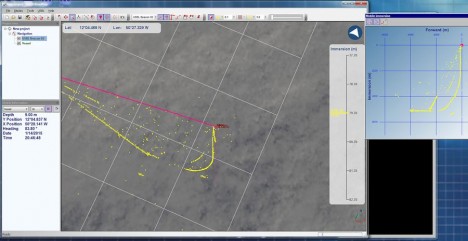
Verfolgen des Schlittens während der Probenahme mittels Pinger / Tracking of the sledge during a deployment. ©Inma Frutos
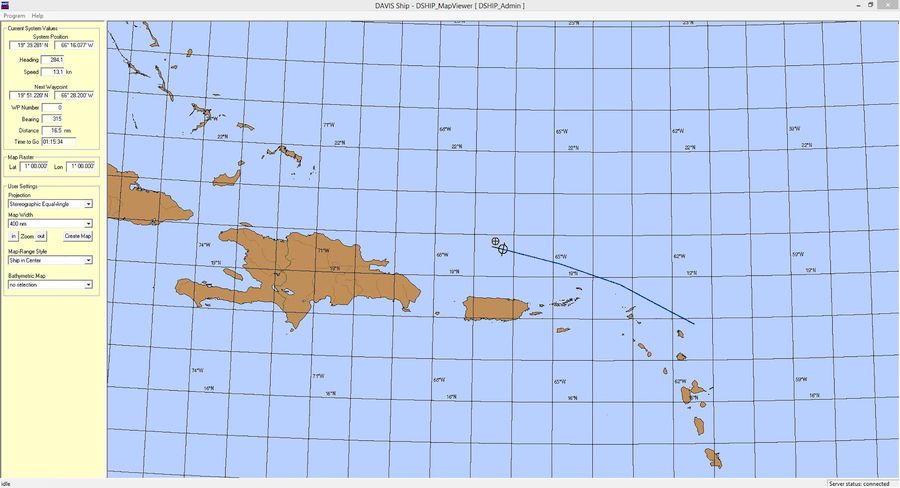
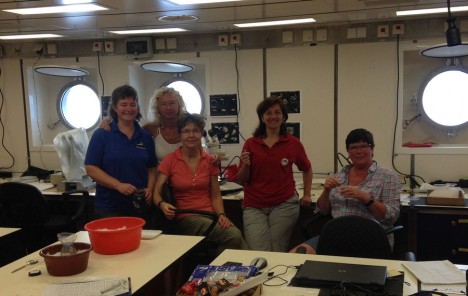
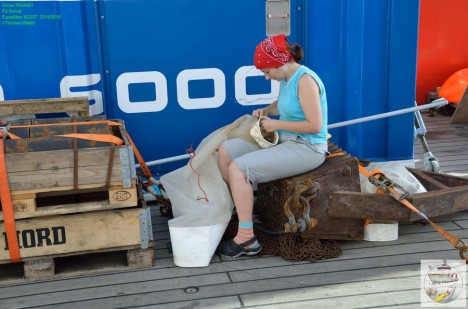
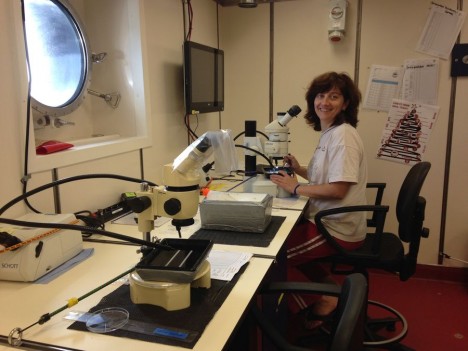
Well done Inma
Lucky the ladies know how to sew or the whole expedition would fall apart.
Hola Inma,
Te mando adjunto algunas referencias bibliográficas interesantes para tu trabajo de investigación a bordo del BO Sonne:
Cebolla JC & Patatas-Fritas CJ, 2015. Filtration efficiency of potato and onion bags used for abyssal peracarid catching: a comparative study. Agricultural Journal of Crustacean Biology, 3911 (2): 201-217.
Hilo, Aguja, Dedal & Desinfectante, 1983*. Embroidery art on suprabenthic nets reported from the XXe century oceanographic expeditions: methods and symbolic representations. Tonterías Subacuáticas Karibeñas, 59 (2): 117-126.
* faltan los nombres de pila en la publicación original…
Buena fin de campaña.
Un fuerte abrazo,
Jean Claude